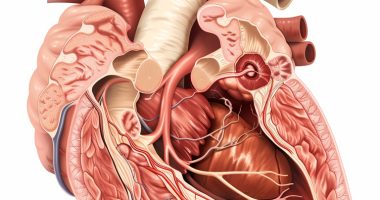Hypoplastic left heart syndrome (HLHS)
Definition
Hypoplastic left heart syndrome (HLHS) is a group of morphologically similar heart defects, including underdevelopment of the left heart, atresia or stenosis of the aortic and/or mitral valve orifice, severe hypoplasia of the ascending aorta, or a combination of these defects. Manifestations of the syndrome develop as the arterial duct closes on the first day of the life of the newborn and are characterized by signs of cardiogenic shock: tachypnea, dyspnea, weak pulse, pallor and cyanosis, and hypothermia. Hypoplastic left heart syndrome diagnosis can be assumed based on two-dimensional echocardiography, cardiac catheterization, radiography, and ECG. Management of patients with left heart hypoplasia syndrome involves infusion of prostaglandin E1, ventilation, correction of metabolic acidosis, and staged surgical correction of the malformation (Norwood operation – Glenn operation or Hemi-Fontaine – Fontaine operation).
General information
Hypoplastic left heart syndrome (HLHS) is a term used to describe a critical congenital heart defect characterized by severe underdevelopment of its left chambers and ascending aorta, as well as mitral or aortic stenosis. The syndrome is among the five most common CHDs in cardiology, along with interventricular septal defect, transposition of the main vessels, Fallot’s tetralogy, and coarctation of the aorta. HLHS accounts for 2-4% of all congenital heart anomalies and is the leading cause of neonatal death in the first days and weeks of life. Boys suffer from this combined heart defect twice as often as girls.
Causes of HLHS
The causes of left heart hypoplasia are not entirely clear. The possibility of autosomal recessive, autosomal dominant, and polygenic types of inheritance is assumed. The theory of multifactorial etiology of the malformation is the most probable.
There are two morphologic variants of HLHS. The first (most severe) variant includes hypoplasia of the left ventricle and atresia of the aortic orifice, which may be combined with atresia or mitral stenosis; in this case, the left ventricular cavity is slit-shaped, and its volume is no more than 1 ml. The second (most common) variant of the malformation has left ventricular hypoplasia, aortic orifice stenosis, and hypoplasia of the ascending aorta combined with mitral stenosis; the left ventricular cavity volume is 1-4.5 ml.
Both variants of left heart hypoplasia are accompanied by the presence of wide-open ductus arteriosus and open oval window, dilatation of the right heart and pulmonary artery trunk, hypertrophy of the right ventricular myocardium; often – endocardial fibroelastosis.
Features of hemodynamics
Severe circulatory disorders in left heart hypoplasia develop soon after birth. The essence of hemodynamic disturbance is determined by the fact that blood from the left atrium cannot enter the hypoplastic left ventricle but instead falls through the open oval window into the right heart, where it mixes with venous blood. This feature leads to right heart volume overload and dilatation, observed since birth.
Subsequently, the main volume of mixed blood from the right ventricle enters the pulmonary artery, while the rest of the oxygen-poor blood flows through the open ductus arteriosus into the aorta and the great circle of blood circulation. Retrogradely, a small amount of blood enters the hypoplastic part of the ascending aorta and the coronary vessels.
In fact, the right ventricle takes on a dual function, pumping blood into the pulmonary and systemic circulation. Blood entering the great circulation circle is possible only through the arterial duct. Therefore, hypoplasia of the left heart is considered a malformation with ductus-dependent circulation. The prognosis for the child’s life depends on keeping the ductus arteriosus open.
Severe hemodynamic disorders lead to marked pulmonary hypertension due to high pressure in the system of small circle vessels, arterial hypotension due to inadequate filling of the large circle, and arterial hypoxemia associated with the mixing of blood in the right ventricle.
Symptoms of HLHS
Clinical signs suggestive of left heart hypoplasia appear in the first hours or 24 hours after birth. They are similar to respiratory distress syndrome or cardiogenic shock.
As a rule, children with HLHS are born prematurely. Newborns are adynamic, with grayish skin color, tachypnea, tachycardia, and hypothermia. At birth, cyanosis is insignificant but soon increases and becomes diffuse or differentiated only on the lower half of the trunk. The extremities are cold to the touch, and peripheral pulsation on them is weakened.
From the first days of life, heart failure with congestive wheezing in the lungs, liver enlargement, and peripheral edema increases. The development of metabolic acidosis, oliguria, and anuria is characteristic. Violation of systemic circulation is accompanied by inadequate cerebral and coronary perfusion, leading to cerebral and myocardial ischemia. In case of arterial duct closure, the child quickly dies.
Diagnosis
In many cases, the diagnosis of left heart hypoplasia syndrome is made before birth when fetal echocardiography is performed. Objective examination of a newborn baby reveals a weak pulse in the arms and legs, shortness of breath at rest, systolic murmur, and gallop rhythm.
ECG shows a deviation of the electrical axis to the right and signs of sharp hypertrophy of the right heart and left atrium. Chest radiography in left heart hypoplasia syndrome reveals a high degree of cardiomegaly, spherical contours of the cardiac shadow, and an increased pulmonary pattern.
Echocardiography reveals the following characteristic signs of cardiac hypoplasia: stenosis of the aortic orifice and its ascending section, decreased size of the left ventricle and enlargement of the right ventricle, and gross changes in the mitral valve.
Probing the heart cavities reveals low blood oxygen saturation in the peripheral arteries, left-right effusion at the atrial level, and increased pressure in the right ventricle and pulmonary artery. Angiocardiography allows visualization of an open ductus arteriosus, hypoplastic ascending aorta, sharply dilated right ventricle, and dilated pulmonary trunk and pulmonary arteries.
Treatment of HLHS
Newborns are monitored in the intensive care unit. Prostaglandin E1 infusion is performed to prevent arterial duct closure. Ventilatory support, correction of metabolic acidosis, and administration of diuretics and inotropic drugs are necessary.
Surgical correction of left heart hypoplasia is performed in stages and sequentially. The first stage of treatment is palliative; it is performed in the first two weeks of life and consists of Norwood surgery to reduce the load on the pulmonary artery and, at the same time, to ensure blood supply to the aorta. In the second stage, at the age of 3-6 months, the child undergoes a Hemi-Fontaine operation (or Glenn’s operation for a bilateral bidirectional cava-pulmonary anastomosis). The final hemodynamic correction of the malformation is performed after about a year by performing Fontaine surgery (total cavopulmonary anastomosis), which allows complete separation of the circulatory circles.
All these treatment options are available in more than 580 hospitals worldwide (https://doctor.global/results/diseases/hypoplastic-left-heart-syndrome-hlhs). For example, Fontan procedure can be done in these countries for following approximate prices:
Turkey $13.7 K in 28 clinics
Germany $40.9 K in 18 clinics
China $44.2 K in 4 clinics
Israel $76.4 K in 4 clinics
United States $77.1 K in 6 clinics.
Prognosis
The malformation is extremely unfavorable in terms of prognosis. About 90% of children with left heart hypoplasia die in the first month of life. The survival rate after the 1st corrective stage is 75%, after the 2nd – 95%, after the 3rd – 90%. Overall, 70% of children survive five years after completely correcting the malformation.
If hypoplasia of the left side of the heart is detected in the child in utero, pregnancy management, and delivery are carried out in a specialized perinatal medical center. From the first days of life, the child should be supervised by a neonatologist, pediatric cardiologist, and cardiac surgeon to correct the malformation as early as possible.


